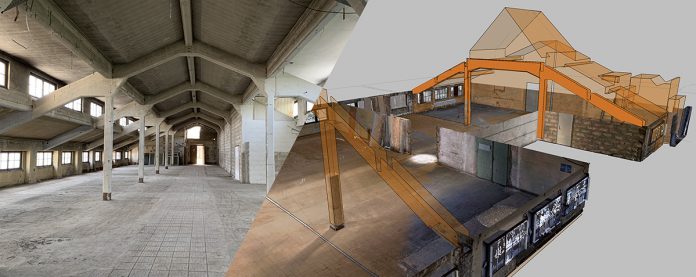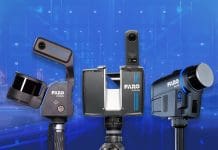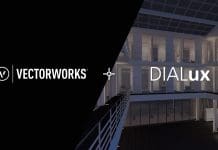FARO’s As-BuiltTM Modeler enables the almost completely automated extraction of 3D modelled surfaces from point cloud data to optimise workflows – all without expensive new software
Ever-evolving as they are, FARO’s latest addition to their catalogue of solutions provides a helpful bridge between traditional, labour-intensive 2D workflows and 3D model, data-driven BIM workflows.
FARO has identified a large swathe of their industry customers where craftsmen are still using CAD design software that does not handle large point cloud data files very well. By providing a solution that allows this group to transform their less-than-optimised workflows without significant financial outlay on new computers and software, customers can begin to engage with other more progressive parts of the industry.
Again, FARO’s development has focused on a solution, rather than simply providing new software, making the process of hardware capture, registration and extraction of modelled objects accessible to a much wider audience.
As-BuiltTM Modeler is a core, standalone product that allows the almost completely automated extraction of 3D modelled surfaces from point cloud data – all without the need for expensive third-party BIM authoring software.
It works by using generic interfaces, tools and icons that will be intuitive. Based upon the FARO Scene software platform (used for registration and federation of separate measurement files), it natively reads the scan project file if the scans have been undertaken using FARO scanning hardware. In this instance, the solution benefits from not requiring an ‘export’ process from other registration software which could introduce errors.
Entry point workflow
Following import of the scan data, the first identified workflow is a simple ‘in-tool’ one whereby the user selects a region of interest in the point cloud, the software will then extract surfaces using a ‘plane of best fit’ and produce a simple yet effective 3D CAD model.
This approach will also extract pipes; the user selects a region, specifies a diameter and the software will search for matches and again deliver a 3D model.
It’s important perhaps at this stage to point out that this is a 3D modelling workflow and not a BIM one, FARO has other tools for that, but this does provide a context model of an existing space which can then be easily imported into design software for design-phase work.
So you need more agility?
The second identified workflow is a more agile modelling workflow and uses an interface described as Send To. Rather than load the point cloud data into the design software, the feature allows a connection between point cloud data and design software, such as McNeel’s Rhinoceros or Nemetscheck’s Allplan. The feature creates a side-by-side view of both the FARO software and the design software, enabling the latter to call upon points in the point cloud to act as a reference for modelling as-built elements in the native tool.
In each of the above workflows, scan data available at any time enables much easier access to more accurate and more complete measurement information. Working with scan data avoids many return site visits or remeasures due to missing measurements, put simply, it saves time and money.
The solution is not restrictive, either – the software has an unlimited capacity of scan data and is not restricted to only FARO scan data formats. All open scan data formats are supported, such as .e57 and .las, meaning users can make the most of this solution even if the scan data is captured by non-FARO hardware, meaning it’s possible to import scan data generated from drones, mobile scanners or from a photogrammetry process. As well as being a standalone product, As-BuiltTM Modeler, FARO also provides plug-ins for Autodesk’s AutoCAD and Revit, catering for an already large user base and perhaps enticing many more into the world of point clouds.
Measure, measure and measure again!
Using FARO As-BuiltTM Modeler, other helpful interrogation tools are available too. As well as distances, area measurements and volume measurements are also possible. Utilising the millimetre accuracy in measurement from scanning hardware enables this and hence millimetre accuracy in design and fabrication. If the scan data is stored on FARO’s SCENE Webshare Cloud, access to the data is even wider, enabling point cloud viewing, measurement, annotation and much more via web browser, democratising the data and improving design team collaboration.
Animation, Virtual Reality and even BIM…
Amazingly, the FARO Video Pro plug-in (bundled with the solution) allows users to create animated visualisations such as fly-throughs or walk-throughs. These can be exported and shared as animation files, something that would have been an expensive outsourced service for most craftsmen previously.
Extending the use to the full FARO SCENE software, the 3D modelled surfaces can be imported to overlay with the original point cloud for further detailed interrogation. This also then affords the opportunity to navigate the model in Virtual Reality (VR) or overlay the view in a 360-degree panoramic image. Showcasing the intended design in context, in more engaging media with fewer errors and greater certainty serves to increase stakeholder buy-in.
With a core aim to create a hybrid solution that fits between CAD and BIM, this solution is a significant step as it is, but the FARO development team do not stand still. Already in the pipeline is a feature that takes the surfaces and objects, categorises them using IFC (Industry Foundation Classes) – the standard for OpenBIM interoperability – and applies the relevant properties to them. This truly is a step into a real BIM workflow and they’re aiming high too by seeking certification from BuildingSMART International.
In summary, the FARO As-BuiltTM Modeler solution really does bridge the gap between 2D workflows and full BIM modelling by automatically generating highly accurate models matching the as-built situation. It simply makes scan data accessible to more people. It also serves as an affordable enabler of digital transformation by upskilling experienced craftsmen and introducing them to the benefits of working with point cloud data and 3D modelling while retaining the comfort of their familiar design tools.
In addition, it’s a low-cost entry point to animation and immersive virtual reality, enabling craftsmen to offer a greater experience and more intelligent digital services to their clients.
Anke Abendroth
FARO EMEA Content Marketing Manager
FARO UK
Tel: +49 (0) 7150 9797 – 311
Twitter: @faroeurope
Please note: this is a commercial profile.














